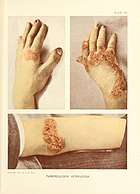Prosector's wart
| Prosector's wart | |
|---|---|
 |
|
| Classification and external resources | |
| Specialty | infectious disease |
| ICD-10 | A18.4 (ILDS A18.440) |
| ICD-9-CM | 017.0 |
Tuberculosis verrucosa cutis (also known as "lupus verrucosus", "prosector's wart", and "warty tuberculosis") is a rash of small, red papular nodules in the skin that may appear 2–4 weeks after inoculation by Mycobacterium tuberculosis in a previously infected and immunocompetent individual.
It is so called because it was a common occupational disease of prosectors, the preparers of dissections and autopsies. Reinfection by tuberculosis via the skin, therefore, can result from accidental exposure to human tuberculous tissue in physicians, pathologists and laboratory workers; or to tissues of other infected animals, in veterinarians, butchers, etc. Other names given to this form of skin tuberculosis are anatomist's wart and verruca necrogenica (literally, generated by corpses).
TVC is one of the many forms of cutaneous tuberculosis, such as the tuberculous chancre (which results from the inoculation in people without immunity), and the reactivation cutaneous tuberculosis (the most common form, which appears in previously infected patients). Other forms of cutaneous tuberculosis are: lupus vulgaris, scrofuloderma, lichen scrofulosorum, erythema induratum and the papulonecrotic tuberculid.
It was described by René Laennec in 1826.
Because the TVC's entry point usually is the site of a trauma, wound or puncture in the skin (during an autopsy, for example), the most frequent site for the wart are the hands. But it can occur anywhere in the skin, such as in the sole of the feet, in the anus, and, in the case of children from developing countries, in the and knees. This is because children from countries of high incidence of tuberculosis can contract the lesion after contact with tuberculous sputum, by walking barefoot, sitting or playing on the ground.
...
Wikipedia
